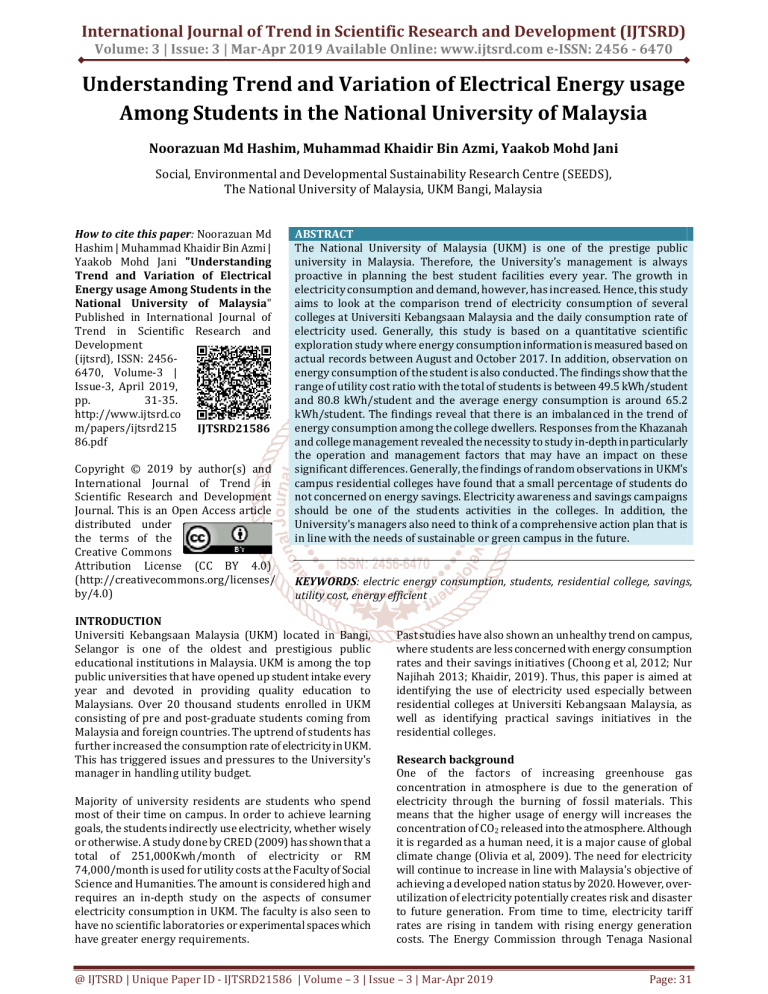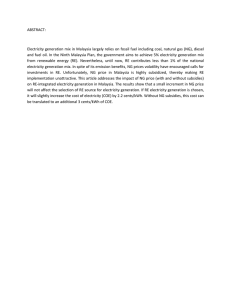
International Journal of Trend in Scientific Research and Development (IJTSRD)
Volume: 3 | Issue: 3 | Mar-Apr 2019 Available Online: www.ijtsrd.com e-ISSN: 2456 - 6470
Understanding Trend and Variation of Electrical Energy usage
Among Students in the National University of Malaysia
Noorazuan Md Hashim, Muhammad Khaidir Bin Azmi, Yaakob Mohd Jani
Social, Environmental and Developmental Sustainability Research Centre (SEEDS),
The National University of Malaysia, UKM Bangi, Malaysia
How to cite this paper: Noorazuan Md
Hashim | Muhammad Khaidir Bin Azmi |
Yaakob Mohd Jani "Understanding
Trend and Variation of Electrical
Energy usage Among Students in the
National University of Malaysia"
Published in International Journal of
Trend in Scientific Research and
Development
(ijtsrd), ISSN: 24566470, Volume-3 |
Issue-3, April 2019,
pp.
31-35.
http://www.ijtsrd.co
m/papers/ijtsrd215
IJTSRD21586
86.pdf
Copyright © 2019 by author(s) and
International Journal of Trend in
Scientific Research and Development
Journal. This is an Open Access article
distributed under
the terms of the
Creative Commons
Attribution License (CC BY 4.0)
(http://creativecommons.org/licenses/
by/4.0)
ABSTRACT
The National University of Malaysia (UKM) is one of the prestige public
university in Malaysia. Therefore, the University’s management is always
proactive in planning the best student facilities every year. The growth in
electricity consumption and demand, however, has increased. Hence, this study
aims to look at the comparison trend of electricity consumption of several
colleges at Universiti Kebangsaan Malaysia and the daily consumption rate of
electricity used. Generally, this study is based on a quantitative scientific
exploration study where energy consumption information is measured based on
actual records between August and October 2017. In addition, observation on
energy consumption of the student is also conducted. The findings show that the
range of utility cost ratio with the total of students is between 49.5 kWh/student
and 80.8 kWh/student and the average energy consumption is around 65.2
kWh/student. The findings reveal that there is an imbalanced in the trend of
energy consumption among the college dwellers. Responses from the Khazanah
and college management revealed the necessity to study in-depth in particularly
the operation and management factors that may have an impact on these
significant differences. Generally, the findings of random observations in UKM's
campus residential colleges have found that a small percentage of students do
not concerned on energy savings. Electricity awareness and savings campaigns
should be one of the students activities in the colleges. In addition, the
University's managers also need to think of a comprehensive action plan that is
in line with the needs of sustainable or green campus in the future.
KEYWORDS: electric energy consumption, students, residential college, savings,
utility cost, energy efficient
INTRODUCTION
Universiti Kebangsaan Malaysia (UKM) located in Bangi,
Selangor is one of the oldest and prestigious public
educational institutions in Malaysia. UKM is among the top
public universities that have opened up student intake every
year and devoted in providing quality education to
Malaysians. Over 20 thousand students enrolled in UKM
consisting of pre and post-graduate students coming from
Malaysia and foreign countries. The uptrend of students has
further increased the consumption rate of electricity in UKM.
This has triggered issues and pressures to the University's
manager in handling utility budget.
Majority of university residents are students who spend
most of their time on campus. In order to achieve learning
goals, the students indirectly use electricity, whether wisely
or otherwise. A study done by CRED (2009) has shown that a
total of 251,000Kwh/month of electricity or RM
74,000/month is used for utility costs at the Faculty of Social
Science and Humanities. The amount is considered high and
requires an in-depth study on the aspects of consumer
electricity consumption in UKM. The faculty is also seen to
have no scientific laboratories or experimental spaces which
have greater energy requirements.
Past studies have also shown an unhealthy trend on campus,
where students are less concerned with energy consumption
rates and their savings initiatives (Choong et al, 2012; Nur
Najihah 2013; Khaidir, 2019). Thus, this paper is aimed at
identifying the use of electricity used especially between
residential colleges at Universiti Kebangsaan Malaysia, as
well as identifying practical savings initiatives in the
residential colleges.
Research background
One of the factors of increasing greenhouse gas
concentration in atmosphere is due to the generation of
electricity through the burning of fossil materials. This
means that the higher usage of energy will increases the
concentration of CO2 released into the atmosphere. Although
it is regarded as a human need, it is a major cause of global
climate change (Olivia et al, 2009). The need for electricity
will continue to increase in line with Malaysia's objective of
achieving a developed nation status by 2020. However, overutilization of electricity potentially creates risk and disaster
to future generation. From time to time, electricity tariff
rates are rising in tandem with rising energy generation
costs. The Energy Commission through Tenaga Nasional
@ IJTSRD | Unique Paper ID - IJTSRD21586 | Volume – 3 | Issue – 3 | Mar-Apr 2019
Page: 31
International Journal of Trend in Scientific Research and Development (IJTSRD) @ www.ijtsrd.com eISSN: 2456-6470
Berhad uses a mechanism that is referred to as Incentive
Based Regulation (IBR) which enables fuel costs to be
adjusted every six months based on fluctuations in global
fuel prices. Hence, the government has to allocate RM150
million subsidy per year to ease the burden of consumers in
Peninsular Malaysia, Sabah and Sarawak.
According to Mohd Noor (2016) the household electrical
appliances market in Malaysia has increased from year to
year. For example, refrigerators' market size has grown from
148,000 units in 1998 to 162,000 units in 2000. While
washing machines have increased from 235,000 units in
1998 to 270,000 units in 2000. This suggests that the usage
would certainly affected the demand for energy in Malaysia.
In addition to industries and households, the use of energy in
higher education institutions also contributes to the increase
in electrical expenditures in Malaysia. In a study done by
Mohd Noor et al. (2016), the Electrical Appliance Review
Study states that the total electricity bills at Kolej Dato 'Onn
Jaafar, Universiti Teknologi Malaysia, in 2011 increased by
RM56,220.99 or 16.5 per cent from RM339,881.11 in 2011
to RM396,102.10 in the year 2012. The increase in the cost is
still ongoing eventhough sustainable electricity usage policy
has been established to reduce the amount of electricity
consumption.
Although the objective of energy usage is to provide comfort
to individuals and communities, but the use should be
efficient and prudent (Sanurya 2014; Brandon 2009).
Ventilation systems such as air conditioners, for example are
the largest components that utilised electrical energy in
Malaysia. According to Jadin et al (2008), energy saving can
be done efficiently and effectively by using timer control
tools to reduce the use of air conditioners when rooms or
booths are not being used. The tool is set automatically in
some rooms and lectures hall. As a result, they found that the
average annual energy saving was RM 5,881.92.
Brandon (2009) conducted a study to view electricity use in
student housing at Pennsylvania University, USA. The high
electricity consumption is due to the use of refrigerators. In
addition, survey respondents point out that students are
prepared to support a sustainable initiative on campus,
including provision of energy-efficient refrigerators.. Finally,
according to survey results, the most effective initiative in
reducing electricity consumption requires individual meter
to detect electricity consumption.
While energy saving may sometimes conflict with comfort,
it's possible to eliminate excessive use of wasteful energy
can be done without compromising comfort (Shashi 2016).
Global climate change is not the only factor why electric
power should be used prudently in Malaysia. Actually, the
increase in electricity rates or tariffs in Malaysia, the
unpredictable inflation and economic downturn problems
are also an important factor in implementing electricity
conservation measures or initiatives (Tiwi 2013). As
students use electronic gadgets like smartphones and
computers, have they ever wondered where the energy came
from? Have they ever wondered if the government had to
cover the cost of generating energy in the form of large
subsidies to facilitate their life in the campus?
Study Area and method
The main campus of Universiti Kebangsaan Malaysia (UKM)
is located at latitude N 2 ° 55 '42.07 " and longitude E 101 °
47' 14.63" (Figure 1). According to the UKM Development
and Planning Department, the UKM area of Bangi campus is
about 32 kilometers south of the Kuala Lumpur City Center
and 8 kilometers to the South Bandar Kajang, which is the
capital of Hulu Langat, Selangor.
Fig1. Location of UKM Bangi, Selangor, Malaysia
Universiti Kebangsaan Malaysia Bangi campus has ten
residential colleges. However, for this study, only five
colleges were involved in the study. The number of college
occupants listed in the schedule includes students, office
staff, cleaners, gardeners, and cafe workers. The majority of
college occupants are UKM students staying in their
respective colleges. The college information are obtained
from the UKM Alumni and Student Development Center
(PPMPA UKM) consisting the latest source of information i.e.
the total number of students enrolling in admission session
college 2017/2018. The source of information for the
number of college occupants other than students is derived
from their respective college office staff . The total number of
residents of the college is the total number of residents of the
college session of 2017/2018 from August 2017 until June
2018.
Generally, this study is based on quantitative-scientific
exploratory perspective, where energy consumption is based
on actual reading observed by the energy manager at UKM.
This is done through the collection of data at each selected
colleges between August and October 2017 as it is the peak
period of energy consumption (Khazanah 2018). In addition,
researchers also conducted surveys/observations on aspects
of wastage and savings made by residents of selected
residential colleges.
In addition, informal interviews were also conducted among
the electrical engineers, staff from the UKM Energy
Management Unit, selected college staffs and students at
each selected colleges. It aims to get their views and
suggestions to save energy consumption at at the National
University of Malaysia. In general, data obtained from the
field of primary data can be analyzed using quantitative
methods through the basic formula to obtain the average
electricity consumption used by a residential dweller taking
into account the value of the college's residential charge of
RM0.30 per kWh.
Observations were conducted at selected colleges at
Universiti Kebangsaan Malaysia. A total of 3 residential
colleges are selected and this is the place where researchers
find most of the primary data. During fieldwork, the
@ IJTSRD | Unique Paper ID - IJTSRD21586 | Volume – 3 | Issue – 3 | Mar-Apr 2019
Page: 32
International Journal of Trend in Scientific Research and Development (IJTSRD) @ www.ijtsrd.com eISSN: 2456-6470
researchers recorded electricity consumption readings at the
electrical meters in each college. The researcher recorded
the reading on a daily basis for a month starting from
January 28 to February 26 in the same year of 2018. The
observation was conducted twice daily at 7.00 am and 7.00
pm. The period is considered to be an appropriate period of
time as it is an early period of semester. The average
standard charge rate for electricity consumption is used by a
residential college occupant can be seen in the study results
and can be compared between the residential colleges on the
standard charges. The comparison can be seen in the highest
energy consumption of selected colleges. This can provide
suggestions on energy saving efforts that can be practiced at
the National University of Malaysia.
Research findings
According to Khazanah (2018), a total of RM23.9 million has
been allocated for the payment of electricity utility in UKM
for 2017. A total of 60.5 million kWh of energy or 42.35
million CO2 was generated during the year. The information
shows that utility cost on the UKM campus are among the
biggest cost that the University manager has to bear. The
residential college is one of the largest component in the use
of the energy. Table 1 to Table 5 show the usages and
charges for the utility cost at all five major colleges in UKM
campus.
Table 1: Energy charges and the Maximum Demand (MD) of Kolej Burhanuddin Helmi (KBH)
(Aug-Oct 2017)
Month
Usage (kWh) Charges (RM) M.D. (kW) Charges (RM) Total (RM)
August
40,040.40
12,012.12
144.28
4,371.68
16,383.80
September
70,544.80
21,163.44
59.23
1,794.67
22,958.11
October
65,631.00
19,689.30
92.40
2,799.72
22,489.02
Total
176,216.20
52,864.86
295.91
Source: Khazanah (2017)
8,966.07
61,830.93
Table 2: Energy charges and the Maximum Demand (MD) of Kolej Aminuddin Baki (KAB)
(Aug-Oct 2017)
Month
Usage (kWh) Charges (RM) M.D. (kW) Charges (RM) Total (RM)
August
53,694.00
16,108.20
75.84
2,297.95
18,406.15
September
84,126.00
25,237.80
178.80
5,417.64
30,655.44
October
79,807.00
23,942.10
186.80
5,660.04
29,602.14
Total
217, 627.00
65,288.1
441.44
13,375.63
78,663.73
Source: Khazanah (2017)
Table 3: Energy charges and the Maximum Demand (MD) of Kolej Rahim Kajai (KRK)
(Aug-Oct 2017)
Month
Usage (kWh) Charges (RM) M.D. (kW) Charges (RM) Total (RM)
August
September
October
Total
47,824.80
68,599.30
64,762.70
181,186.80
14,347.44
77.32
20,579.79
138.36
19,428.81
152.36
54,356.04
368.04
Source: Khazanah (2017)
2,342.80
4,192.31
4,616.51
11,151.61
16,690.24
24,772.10
24,045.32
65,507.65
Table 4: Energy charges and the Maximum Demand (MD) of Kolej Dato’ Onn (KDO)
(Aug-Oct 2017)
Month
Usage (kWh) Charges (RM) M.D. (kW) Charges (RM) Total (RM)
August
September
October
Total
21,514.00
48,440.9
48,156.4
118, 111.3
6,454.20
30.02
14,532.27
113.5
14,446.95
98.79
35,433.42
242.31
Source: Khazanah (2017)
909.60
3,439.05
2,993.33
7341.98
7,363.8
17,971.32
17,440.28
42,775.4
Table 5: Energy charges and the Maximum Demand (MD) of Kolej Tun Hussein Onn (KTHO)
(Aug-Oct 2017)
Month
Usage (kWh) Charges (RM) M.D. (kW) Charges (RM) Total (RM)
August
26,977.50
8,093.25
48.39
1466.22
9,559.47
September
44,465.50
13,339.65
90.56
2,743.97
16,083.62
October
Total
38,984.70
110,427.70
11,695.41
98.55
33,128.31
237.50
Source: Khazanah (2017)
2,986.07
7,196.25
@ IJTSRD | Unique Paper ID - IJTSRD21586 | Volume – 3 | Issue – 3 | Mar-Apr 2019
14,681.48
40,324.56
Page: 33
International Journal of Trend in Scientific Research and Development (IJTSRD) @ www.ijtsrd.com eISSN: 2456-6470
The result shows that KBH recorded electricity consumption
of 176,215.80 kWh (Table 1). The KAB recorded amount of
217,627 kWh (Table 2), while KRK recorded at 181, 186.80
kWh (Table 3). The KDO recorded amount of 118,111.3 kWh
(Table 4) and lastly, KTHO recorded at 110,427.70 kWh
(Table 5). The table also show that KBH recorded a charge of
RM52,864.86 within the 3-month period. The KAB recorded
as RM 65, 288.1, KRK (RM 54,356.04), KDO (RM 35,433.42)
and KTHO recorded RM 33,128.31. This shows that
Aminuddin Baki College (KAB) has the highest electricity
consumption reading among selected colleges with reading
of 217,627 kWh. Tun Hussein Onn College (KTHO) has the
lowest electricity consumption readings compared with the
selected colleges with 110,427.70 kWh equivalent of
33,128.31 RM within the 3-month period.
Based on the ratio between utility cost and the number of
students, it is found that KBH is the college with the highest
score of 80.8 kWh/student, compared with other colleges of
KAB (68.5 kWh/student), KRK (67.1 kWh/ student , KUO
(59.9 kWh / student) and KTHO (49.5 kWh / student). The
differences of utility cost ratios with total students is about
31.7 kWh/student and the average energy consumption is
around 65.2 kWh/student. The findings reveal the imbalance
in trend of energy consumption among the colleges.
Responses from the Khazanah and College management also
revealed the need to study in-depth about it, particularly the
college's operations and management factors that may have
an impact on these significant differences. However, results
relating to Maximum Demand (MD) values have shown that
the highest number of students in the KAB (total number of
students = 953) resulted in the highest MD value of 441.44
kW, while the lowest MD value was recorded at 237.5 kW.
Figure 2 to Figure 4 shows the daily trend of electricity
consumption in KRK, KBH and KAB. Daily consumption
analysis has found that nighttime energy consumption
trends are higher than during the day. Rahim Kajai College
(KRK) had the highest reading on February 23, 2018 at night
with electricity consumption of 2,767 kWh, compared with
KBH of 2,265 kWh on February 21, 2018 while KAB of 1,689
kWh on February 13, 2018.
Figure4. Daily trend of electricity consumption of KAB
(28 January to 26 Februari 2018)
The high usage of nighttime compared to daytime can be
attributed to learning activities as well as their free times in
the residential area. Low electricity consumption during the
day is due to the fact that most students are within campus
environment to attend their respective classes. The results of
this study are equivalent to the study conducted by Mohd
Nor et al (2016). The observation revealed that only a small
percentage of students do not concerned on their energy
savings at colleges. However, the male students are willing to
close their lights and fans while leaving their rooms. Ongoing
campaigns and reminders from college managers should be
done from time to time to ensure electricity savings at the
residential colleges. Electricity awareness and savings
campaigns should be one of the agendas of student activities
in residential colleges. Students and instructors, should be
reminded to save electricity by closing electrical equipment
such as phone chargers, laptop chargers, lamps, and so forth
if they are not used.
Figure2. Daily trend of electricity consumption of KRK
(28 January to 26 Februari 2018)
In addition, the University's manager also need to think of a
comprehensive action plan that is in line with the needs of
sustainable campus development in the future. One of the
actions that should be taken immediately is to think about
the use of energy-efficient air conditioning components. This
is because, the cooling aspect of space is one of the largest
energy wastage in tropical countries such as Malaysia (Liang
& Jinxing 2015; Jadin et al 2008) In addition, the air
conditioner should be maintained regularly so that the air
conditioner can function properly. In addition, universities
can also diversify renewable energy such as solar energy,
wind and biomass in reducing electricity consumption. The
use of renewable energy can save the spending on utility
bills as well as expanding research and development on new
sustainable products.
Figure3. Daily trend of electricity consumption of KBH
(28 January to 26 Februari 2018)
Conclusion
This study has identified the trend of electricity consumption
in selected residential colleges at Universiti Kebangsaan
Malaysia. The results showed that there was a significant
difference in the energy consumption trend among the
residential colleges. The difference in energy consumption
during day and night is also very significant among the
residential colleges. The result is expected to be a useful
guide in reducing electricity consumption in residential
colleges in UKM. It is also will benefited to the energy
manager especially in designing and implementing efficient
energy saving plans at the their campus.
@ IJTSRD | Unique Paper ID - IJTSRD21586 | Volume – 3 | Issue – 3 | Mar-Apr 2019
Page: 34
International Journal of Trend in Scientific Research and Development (IJTSRD) @ www.ijtsrd.com eISSN: 2456-6470
References
[1] Brandon Gollotti (2009). Energy Use in Penn's Student
Housing and Techniques to Achieve Energy Reduction:
University of Pennsylvania. Senior Seminar Papers. 11
[2] Bernama (14 April 2016) Kerajaan kaji potensi tenaga
angin jana bekalan elektrik. Malaysia Kini. Diperolehi
daripada
https://www.malaysiakini.com/news/337824
[3] Choong Weng Wai, Yin Fong Chong, Sheau Ting Low,
Abdul Hakim bin Mohammed (2012). Implementation
of Energy Management Key Practices in Malaysian
Universities. 2(3), 455-477.
[4] Christopher P. Barlett (2017). From theory to practice:
Cyberbullying Theory and its Application to
Intervention: Gettysburg College, USA. 72 (2017) 269275
[5] CRED (2009). Carbon reduction @ UKM. Energy
efficiency in campus. http://www.ukm.my/energy/
[6] Liang Zhao, Jili Zhang & Jinxing Ma (2015). The
Application of Building Energy Consumption Index in
Campus Energy Efficiency Management Platform:
Dalian University of Technology. China. Vol. 9, No. 7
(2015), 103-112.
[7] Khaidir, M. 2019. Electricity consumption between
residential colleges: A case study at the National
University of Malaysia. Thesis. Undergraduate
(Geography). UKM unpublished.
[8] Khazanah. (2017) Exclusive interview with Khazanah
officers in January 10th, 2017.
[9] Khazanah (2018). Exclusive interview with Khazanah
officers in May 13th, 2018.
[10] M. S. Jadin, N. Md. Saad, S. N. S. Ab. Rahman, M. F. Abas,
A. H. M. Hanafi & A. Walik (2008). The Effect of Using
Timer to the Split Unit Air-Conditioning Control in
UMP’s Lecture Halls and Labs: 2nd Engineering
Conference on Sustainable Engineering Infrastructures
Development & Management December 18 -19
[11] Mohd Noor Azli Ali Khan, Muhamad Syakir Shukor,
Mohd Amri Md Yunus, Yanuar Zulardiansyah Arief &
Mohamad Hairil Abdul Ghani (2016). Kajian
Penggunaan Peralatan Elektrik di Kolej Dato’ Onn
Jaafar, Universiti Teknologi Malaysia
[12] Nur Najihah Abu Bakar, Mohammad Yusri Hassan,
Hayati Abdullah, Hasimah Abdul Rahman, Md Pauzi
Abdullah, Faridah Hussin and Masilah Bandi, (2013).
Sustainable Energy Management Practices and Its
Effect on EEI: A Study on University Buildings.
Proceedings of Global Engineering, Science and
Technology Conference 1-2 April. Dubai, UAE. 1– 11.
[13] Olivia Guerra Santin, Laure Itard, Henk Visscher
(2009). The effect of occupancy and building
characteristics on energy use for space and water
heating in Dutch residential stock. 41 (2009), 1223–
1232.
[14] Prashik P. Kamble & Rahul K. Kamble (2014). Energy
Audit of Sardar Patel College, Chandarpur, Central
India: Sardar Patel College, Chandrapur. Volume-3,
Issue-3
[15] Robin Kundis Craig (2010) Constitutional Contours for
the Design and Implementation of Multistate
Renewable Energy Programs and Projects. 81 U. Colo.
L. Rev. 771
[16] Sanurya Putri Purbaningrum (2014). Audit Energi dan
Analisis Peluang Penghematan Konsumsi Energi Listrik
pada Rumah Tangga: Universitas Muhammadiyah
Surakarta. Vol 15, No.1, 26-33.
[17] Shashi Kant Srivastava (2016). Causal Relationship
between Electricity Consumption and GDP: Plausible
Explanation on Previously Found Inconsistent
Conclusions for India: Indian Institute of Management,
Indore, India. 6, 276-281
[18] Tiwi Kamidin (2013). Audit Hijau Penggunaan Elektrik
dan Air di Institusi Pendidikan Guru Kampus Batu
Lintang Kuching: Jurnal Penyelidikan IPG KBL, Jilid 11,
2013
@ IJTSRD | Unique Paper ID - IJTSRD21586 | Volume – 3 | Issue – 3 | Mar-Apr 2019
Page: 35







